New Orleans Now
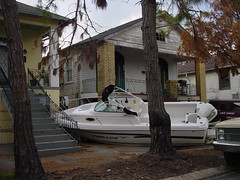 Since I've been in Baton Rouge for over a week now, I figured it would be inexcusable for me to not visit New Orleans at least once. So the other day, I joined my cousin Lance, his wife Erin, and our Aunt Andree on a trip through the city. Lance is a firefighter, and was involved in the rescue efforts after the hurricane, so he was a perfect guide to show us around. He knew a lot about what happened where, and what has been and is being done to recover. We all took a lot of pictures, and I'll be updating my flickr page with theirs when I get them. So far, you can at least check out my photos.
Since I've been in Baton Rouge for over a week now, I figured it would be inexcusable for me to not visit New Orleans at least once. So the other day, I joined my cousin Lance, his wife Erin, and our Aunt Andree on a trip through the city. Lance is a firefighter, and was involved in the rescue efforts after the hurricane, so he was a perfect guide to show us around. He knew a lot about what happened where, and what has been and is being done to recover. We all took a lot of pictures, and I'll be updating my flickr page with theirs when I get them. So far, you can at least check out my photos.One thing that struck me was the sensation that some areas were not as bad as I thought, even to the point of seeming completely normal, and then other areas were absolutely as bad as you can imagine.
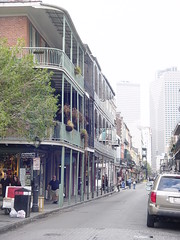 The change was often a matter of turning a corner or crossing a block. For example, the French Quarter, fortunately, is on pretty high ground, so those old, dilapidated restaurants, bars, and shops that have been built upon older buildings that were built upon even older buildings are all still standing and functional. The electricity there was restored pretty quickly, and there are street vendors, tourists, and jazz musicians on the corners. The only noticeable change in the Quarter is that it's less crowded and there were a lot of hurricane katrina t-shirts for sale.
The change was often a matter of turning a corner or crossing a block. For example, the French Quarter, fortunately, is on pretty high ground, so those old, dilapidated restaurants, bars, and shops that have been built upon older buildings that were built upon even older buildings are all still standing and functional. The electricity there was restored pretty quickly, and there are street vendors, tourists, and jazz musicians on the corners. The only noticeable change in the Quarter is that it's less crowded and there were a lot of hurricane katrina t-shirts for sale.The next thing you know, you're practically in a third world country. As soon as you get out of the Quarter, there's no electricity, so all the intersections have temporary stop signs set up. There are gigantic piles of trash and rubble lining the streets. Dishwashers, refrigerators, & washers and dryers are lined up, outside, broken. One fridge had a graffiti message spraypainted on the door: "Do Not Open!" There were literally hundreds of abandoned cars, suvs, and trucks. Doors and trunks were wide open and windows were broken. Most of them were covered with a grayish white film leftover from the floodwater.
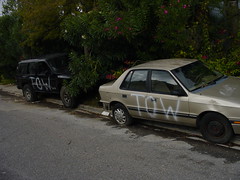
As we drove through the neighborhoods, we kept noticing the brown stain on garages, trees, and sides of houses where the waterline had been. Lance was especially aware of the fact that we were driving in places that were underwater a month and a half ago; he had seen the same neighborhoods from 6 to 10 feet higher in his boat, and he said everything seemed different from the "normal" angle.
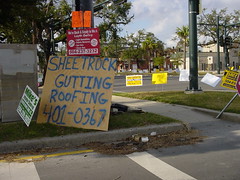 There are signs everywhere you look, many handmade, for practically any kind of service that people in this situation would need. One said: "Computer flooded? We can retrieve your files." Another was for restoration of damaged photographs. Lots were advertising "home-gutting" and "de-molding". It was surreal to know that this is basically the only economy in New Orleans right now.
There are signs everywhere you look, many handmade, for practically any kind of service that people in this situation would need. One said: "Computer flooded? We can retrieve your files." Another was for restoration of damaged photographs. Lots were advertising "home-gutting" and "de-molding". It was surreal to know that this is basically the only economy in New Orleans right now.With the exception of the Quarter, just about all the "standard" businesses are closed, but we did find some nice suprises. Lance and Erin's favorite hole-in-the-wall Italian joint was up and running, so we had a great lunch, and there were some entrepreneurial-minded folks who had bare bones tent shops: like the barber cutting hair in a closed Shell station parking lot. Those people are mainly catering to FEMA and Red Cross employees, though. Other than relief workers, there are not many people around; it really feels like a ghost town, especially in the neighborhoods, where block after block is basically uninhabitable.
Now that the water is gone, there's a sense that the urgency and the emergency is over. But it's painfully obvious when you walk or drive around that the job of making New Orleans liveable, much less a nice place to be, is going to take a long, long, long-ass time. here's the link to the flickr jive.
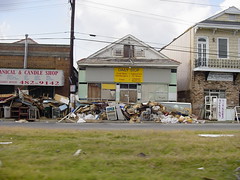


0 Comments:
Post a Comment
<< Home